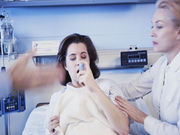Strong correlation seen for eosinophil peroxidase levels in adults with poorly-controlled asthma
WEDNESDAY, Dec. 16, 2015 (HealthDay News) — For individual patients with poorly-controlled asthma, nasal and pharyngeal eosinophil peroxidase (EPX) levels are strongly associated with the eosinophil percentage of induced sputum, according to a study published online Dec. 8 in Allergy.
Matthew A. Rank, M.D., from the Mayo Clinic in Scottsdale, Ariz., and colleagues compared nasal, pharyngeal, and sputum EPX levels with induced sputum eosinophil percentage in 10 adults with poorly-controlled asthma and 10 controls.
The researchers observed a significant difference in sputum EPX levels between asthma and control subjects (P = 0.024). EPX levels measured in nasal and pharyngeal swab samples derived from the same patients were significantly different between asthma and control subjects (each P = 0.002). Compared with induced sputum eosinophil percentage, Spearman’s correlation coefficients for nasal EPX and pharyngeal EPX levels were 0.81 (P = 0.0007) and 0.78 (P = 0.0017), respectively.
“There is a strong association in a given patient between both nasal and pharyngeal EPX levels and the eosinophil percentage of induced sputum,” the authors write. “The use of nasal or pharyngeal swabs may represent a clinically relevant diagnostic metric whose simplicity of use would provide a novel point-of-care assay in the management of asthma patients.”
Members of Lee Laboratories reviewed the manuscript.
Copyright © 2015 HealthDay. All rights reserved.








